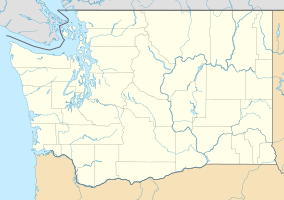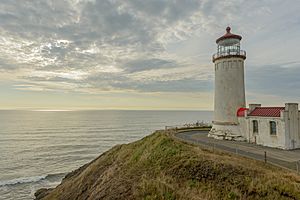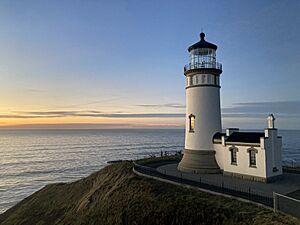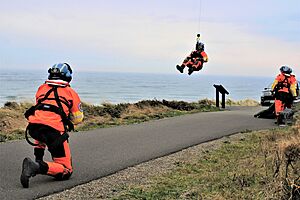Cape Disappointment State Park facts for kids
Quick facts for kids Cape Disappointment State Park |
|
|---|---|

South end of Cape Disappointment and its lighthouse
|
|
| Location | Pacific County, Washington, United States |
| Area | 2,023 acres (8.19 km2) |
| Elevation | 20 ft (6.1 m) |
| Established | Early 1950s |
| Operator | Washington State Parks and Recreation Commission |
| Website | Cape Disappointment State Park |
Cape Disappointment State Park is an amazing place to visit! It used to be called Fort Canby State Park. This public park is located on Cape Disappointment in Washington state. It sits right where the mighty Columbia River flows into the huge Pacific Ocean.
The park covers about 2,023 acres. It has many different kinds of nature to explore. You can find old-growth forests, calm freshwater lakes, and marshy areas. There are also beautiful tidelands along the ocean. Inside the park, you can visit Fort Canby, the Lewis and Clark Interpretive Center, and two lighthouses: North Head Lighthouse and Cape Disappointment Lighthouse. This park is also part of the larger Lewis and Clark National Historical Park.
Contents
History of Cape Disappointment
How the Cape Got Its Name
The name "Cape Disappointment" comes from a time long ago. In 1788, a captain named John Meares tried to sail into the Columbia River. He couldn't find the entrance and felt very disappointed. That's how the cape got its name!
Later, in 1792, an American captain named Robert Gray successfully sailed into the river. Then, in 1805, the famous Lewis and Clark Expedition reached Cape Disappointment. This was a big moment in their journey across America.
Forts and Protection
During the American Civil War in 1862, a military camp was built here. It was called Post at Cape Disappointment. Its job was to protect the mouth of the Columbia River. Soldiers wanted to stop any attacks from enemy ships.
In 1863, another fort, Fort Stevens, was built on the other side of the river. In 1864, the post here was renamed Fort Cape Disappointment. You can still see some of these old Civil War forts today. They include the Tower Battery, Left Battery, and Center Battery.
From Fort to Park
Fort Cape Disappointment grew bigger and was renamed Fort Canby in 1875. By 1906, it became part of a group of three forts. These forts protected the Columbia River. Fort Canby was expanded even more during World War II.
After the war, the fort was no longer needed by the military. In the early 1950s, it became a state park. Workers from the Civilian Conservation Corps helped restore the fort in the 1930s. They also improved roads and trails for visitors.
What to See and Do
Lewis and Clark Interpretive Center
The Lewis and Clark Interpretive Center is a must-see! It sits high on a cliff. From there, you can see where the Columbia River meets the Pacific Ocean. Inside, you'll learn all about the amazing journey of the Lewis and Clark Expedition. They traveled from St. Louis, Missouri to the Pacific coast between 1803 and 1806.
The center also teaches you about the park's history. You can learn about the lighthouses, the U.S. Coast Guard, and military activities. Plus, there are exhibits about the area's sea life and natural environment.
Outdoor Adventures
Cape Disappointment State Park has lots of fun things to do outdoors!
- You can go camping or stay overnight in other cozy places.
- There are about 8 miles of hiking trails to explore.
- Walk among giant Sitka spruce trees in the old-growth areas.
- If you love being on the water, there are places to launch your boat.
- Enjoy a picnic with your family and friends.
- Take a tour of the North Head Lighthouse.
Many of the old military buildings from World War II are still in the park. You can explore these historic ruins.
Camping and Stays
The park offers many ways to stay overnight. You can choose from:
- Standard campsites for tents.
- RV sites with full hookups for your camper.
- Cozy yurts.
- Comfortable cabins.
- Even historic vacation homes!
The camping areas have restrooms with showers. There's also a park store nearby. You can buy groceries, firewood, and even grab a bite at the café.







